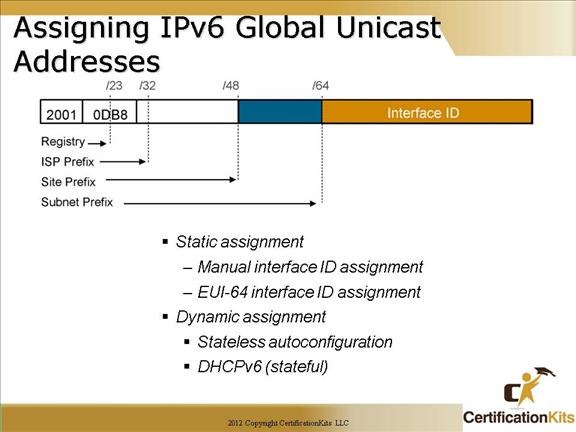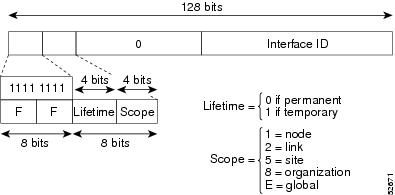- Unicast – One to One
- Multicast – One to Many
- Anycast – new concept and means One to Nearest (based on routing)
In IPv4 broadcasts caused problems like interupts in every node in network and in some cases triggering broadcast storms. BC is not anymore used in IPv6 instead multicast is used.
IPv6 Global unicast address
Global unicast address is structured in a way that enable efficient aggregation of routing prefixes so that number of routing table entries in the global routing table can be reduced. Global unicast addresses are agregated upwards through organizations and eventually to ISPs as you can see in picture below:
Addresses with prefix 2000::/3 through E000::/3 excluding the FF00:/8 (multicast address) is current global unicast address assignment by IANA.
IPv6 Link-Local unicast addresses
link local addresses have a scope limited to the local link and are dynamically created on all ipv6 interfaces using a specific link local prefix FE80/10 and a 64 bit interface identifiers. Link local addresses are used for automatic address configuration, neighbor discovery, router discovery and by many routing protocols.
IPv6 multicast addresses
An interface can belong to any number of multicast groups. Multicasting is extremely important for IPv6 cause it replace Broadcast. The structure of an ipv6 multicast address is illustrated at picture below. IPv6 multicast addresses are defined by the prefix FF00::/8. The second octed define lifetime and scope. Lifetime specify if the the multicast address is permanent and well known (flag equal to 0) in case it is temporary (transient) the T flag is set to 1. The 4 bit scope then indicate how the name is saying the scope of validity multicast address itself. 1 for node scope (loopback), 2 for link scope, 5 for site-local scope, 8 for organizational scope and E for global scope.
For example FF02::/16 is a permanent multicast adderss with a link local scope. The multicast group ID consist of the 112 bits of multicast address ( the last 16 bits is for defining the specific function)
For example:
FF02::1 – all nodes on a link
FF02::2 – all routers on a link
FF02::9 – all RIP routers on a link
Solicited-Node mutlicast address
solicited-node multicast address is used in IPv6 during address resolution of an IPv6 to MAC address on a LAN segment. This is similar to ARP process at IPv4. It has this structure- FF02::1:FFXX:XXXX where far right 24 bits (the X ones) correspond to unicast or anycast address of a node. The neighbor discovery process uses the solicited-node multicast address for MAC address resolution.In rare cases the Solicited-Node multicast address can be duplicit in a LAN segment but this will not cause a problem because the NS message contains also the full IPv6 address of node that we are looking for and that is unique.
IPv6 Anycast addressses
IPv6 anycast address is global unicast address assigned to more than one interface. That means that anycast addresses are allocated from the unicast address space and have the same format as unicast addresses, so they are indistinguishable from unicast addresses. When unicast address is assigned to more than one interface – thus turning into anycast address – the nodes to which address is assigned must be explicitly configured to know that they are using anycast address. (On cisco router you use the anycast keyword when assigning the IPv6 address)

